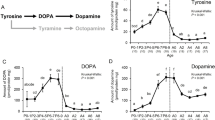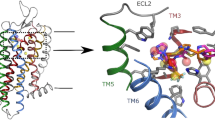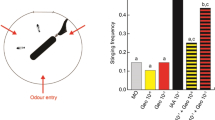Abstract
HONEY bees (Apis mellifera L.) attract each other by a variety of biological stimuli. The olfactory stimulus produced by the worker bees has received attention during a number of investigations ever since Sladen1 suggested that the attractant odour originated from a special organ discovered by Nassanoff in 1883. This scent organ is located on the anterior part of the seventh abdominal tergum of the worker bee.
This is a preview of subscription content, access via your institution
Access options
Subscribe to this journal
Receive 51 print issues and online access
$199.00 per year
only $3.90 per issue
Buy this article
- Purchase on Springer Link
- Instant access to full article PDF
Prices may be subject to local taxes which are calculated during checkout
Similar content being viewed by others
References
Sladen, F. W. L., Entomol. Mon. Mag., 38, 208 (1902).
Frisch, K. v., and Rösch, G. A., Z. vergl. Physiol., 4, 1 (1926).
Karlson, P., and Butenandt, A., Ann. Rev. Entomol, 4, 39 (1959).
Renner, M., Z. vergl. Physiol., 43, 411 (1960).
Brown, I., Nature, 188, 1021 (1960).
Porter, J. W., Drugs Affecting Lipid Metabolism, 30 (Elsevier, Amsterdam, 1961).
Author information
Authors and Affiliations
Rights and permissions
About this article
Cite this article
BOCH, R., SHEARER, D. Identification of Geraniol as the Active Component in the Nassanoff Pheromone of the Honey Bee. Nature 194, 704–706 (1962). https://doi.org/10.1038/194704b0
Issue Date:
DOI: https://doi.org/10.1038/194704b0
This article is cited by
-
Antenna movements as a function of odorants’ biological value in honeybees (Apis mellifera L.)
Scientific Reports (2022)
-
Pheromone components affect motivation and induce persistent modulation of associative learning and memory in honey bees
Communications Biology (2020)
-
The terpenes of leaves, pollen, and nectar of thyme (Thymus vulgaris) inhibit growth of bee disease-associated microbes
Scientific Reports (2018)
-
Pheromones modulate reward responsiveness and non-associative learning in honey bees
Scientific Reports (2017)
-
Aversive learning overcomes appetitive innate responding in honeybees
Animal Cognition (2012)
Comments
By submitting a comment you agree to abide by our Terms and Community Guidelines. If you find something abusive or that does not comply with our terms or guidelines please flag it as inappropriate.



